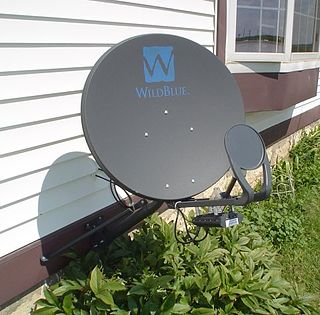
The Defense Information Systems Agency (DISA), known as the Defense Communications Agency (DCA) until 1991, is a United States Department of Defense (DoD) combat support agency composed of military, federal civilians, and contractors. DISA provides information technology (IT) and communications support to the President, Vice President, Secretary of Defense, the military services, the combatant commands, and any individual or system contributing to the defense of the United States.

Satellite Internet access is Internet access provided through communication satellites; if it can sustain high speeds, it is termed satellite broadband. Modern consumer grade satellite Internet service is typically provided to individual users through geostationary satellites that can offer relatively high data speeds, with newer satellites using Ku band to achieve downstream data speeds up to 506 Mbit/s. In addition, new satellite internet constellations are being developed in low-earth orbit to enable low-latency internet access from space.
Hispasat is the operating company for a number of Spanish communications satellites that cover the Americas, Europe and North Africa from orbital positions 30.0° West and 61.0° West. It was formed in 1989 and its activities include provision of communication services in the commercial and government sectors. Hispasat's fleet of satellites broadcast more than 1250 television channels and radio stations to more than 30 million homes, as well as providing services such as broadband to mobile telephones and landlines.
THAICOM 4, also known as IPSTAR 1, is a high throughput satellite built by Space Systems/Loral (SS/L) for Thaicom Public Company Limited. It was launched on August 11, 2005, from the European Space Agency's spaceport in French Guiana on board the Ariane rocket. The satellite had a launch mass of 6486 kilograms and is from SS/L's LS-1300 series of spacecraft.
AMC-3 is a commercial broadcast communications satellite owned by SES World Skies, part of SES S.A.. Launched on 4 September 1997, from Cape Canaveral, Florida, AMC-3 is a hybrid C-band / Ku-band satellite. It provides coverage to Canada, United States, Mexico, Caribbean. Located in a geostationary orbit parallel to the Yucatán Peninsula and Great Lakes, AMC-3 provides service to commercial and government customers, with programming distribution, satellite news gathering and broadcast internet capabilities.
Astra 1E is one of the Astra communications satellites in geostationary orbit owned and operated by SES. It was launched in October 1995 to the Astra 19.2°E orbital slot initially to provide digital television and radio for direct-to-home (DTH) across Europe.

Inmarsat is a British satellite telecommunications company, offering global mobile services. It provides telephone and data services to users worldwide, via portable or mobile terminals which communicate with ground stations through fifteen geostationary telecommunications satellites.
Galaxy 28 is a communications satellite owned by Intelsat located at 89° West longitude, serving the North America and South America market.
It was built by Space Systems/Loral, as part of its SSL 1300 line = . aka Galaxy 28 was formerly known as Telstar 8 and Intelsat Americas 8. This satellite provides services in the C-band, Ku-band, and Ka-band.
XTAR, LLC is a commercial satellite operator exclusively providing services in the X band frequency range, which is the communications cornerstone of today's military, diplomatic, humanitarian and emergency disaster response operations. A privately owned and operated company, XTAR supports the critical satellite communications needs of governments around the world through its two X-band payloads. The XTAR satellites were designed and built by private financing. Loral Space & Communications, Inc. owns the majority share. XTAR is headquartered in Ashburn, VA.
AMC-7 is a commercial broadcast communications satellite owned by SES S.A., originally from the GE Americom fleet. Launched on 14 September 2000, at 22:54:07 UTC from the Centre Spatial Guyanais in Kourou, AMC-7 provides C-band coverage to United States, Caribbean, Mexico, and is located in a geostationary orbit over the Pacific Ocean east of Hawaii. The satellite is primarily used for cable television programming distribution.
Astra 4A is one of the Astra communications satellites owned and operated by SES at the Astra 5°E orbital slot providing digital television and radio broadcasts, data, and interactive services to Nordic countries, eastern Europe and sub-Saharan Africa in the 11.70 GHz-12.75 GHz range of the Ku band and 18.8 GHz-21.75 GHz range of the Ka band.

O3b is a satellite constellation in Medium Earth orbit (MEO) owned and operated by SES, and designed to provide low-latency broadband connectivity to remote locations for mobile network operators and internet service providers, maritime, aviation, and government and defence. It is often referred to as O3b MEO to distinguish these satellites from SES's forthcoming O3b mPOWER constellation.

Tooway is a satellite broadband Internet service available across Europe. The first version of the service was launched in 2007 via two Eutelsat geostationary satellites, Hot Bird 6 and Eurobird 3, respectively at the 13° and 33° East orbital positions.
SwiftBroadband is an IP-based packet-switched communications network that provides a symmetric ‘always-on’ data connection of up to 650 kbit/s per channel for aircraft globally except for the polar regions, using the Inmarsat satellite constellation.
High-throughput satellite (HTS) is a communications satellite that provides more throughput than a classic FSS satellite for the same amount of allocated orbital spectrum, thus significantly reducing cost-per-bit. ViaSat-1 and EchoStar XVII do provide more than 100 Gbit/s of capacity, which is more than 100 times the capacity offered by a conventional FSS satellite. When it was launched in October 2011 ViaSat-1 had more capacity than all other commercial communications satellites over North America combined.
The XTAR-EUR is a communication satellite developed by Spain and the United States and in order to provide a secure channel over the Indian Ocean. It was originally operated by XTAR and Hisdesat. In year 2020 Hisdesat bought 100% stake on the satellite. Its launch short after the Spainsat is part of an effort to strengthen Spain's communication ties with allied countries around the globe, particularly in maters of national security.
The Amazonas 5 is a Spanish commercial communications satellite developed by SSL and operated by Hispasat. Launched on September 11, 2017, it has an expected service life of 15 years. Its orbit allows it to cover all of South America, allowing for broadband and broadcast services. It replaces the Amazonas 4A and 4B satellites, the former of which experienced a performance loss and the latter which was cancelled.
Eutelsat 172B is a French communications satellite built by Airbus Defence and Space and operated by Eutelsat Communications. Launched on June 1, 2017, it has an expected service life of 15 years. Its orbit along with Eutelsat 172A allows it to cover the Asia-Pacific region, providing enhanced broadband and broadcast services.
The Hispasat 1D, since 2016 called Hispasat 30W-4 is a Spanish communications satellite launched in 2002 operated by Hispasat. Together with the Hispasat 1C it formed a constellation in order to strengthen communication ties between the American continent and the Iberian Peninsula for both governmental and private uses.




